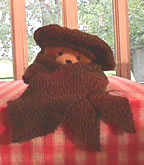
Hand Knit Scarf/Afghan
Knit: My afghan is a "KIP" (Knit in progress.)
I'm wearing one of the panels as a scarf. Teddy is wearing another version as a scarf. I'll post the completed afghan at my blog!
I'm wearing one of the panels as a scarf. Teddy is wearing another version as a scarf. I'll post the completed afghan at my blog!
 Characteristics of the scarf/afghan:
Characteristics of the scarf/afghan:
- The afghan is knit in strips which are sewn together to form an afghan.
- The
individual strips make nice scarves. Due to decreases at the
edges, , the long edges don't curl even if the scarf is knit in
stockinette. (The hem does curl though. This is easy to fix up after
you finish the afghan or scarf. I like the edges to curl when I felt, because they just make a nice beaded edge.)
- Knit about 6 scarves to make an afghan-- but you can decide the number for yourself.
- Can be knit in garter stitch or stockinette. I'm modeling a scarf knit in stockinette; Teddy's in knit in garter stitch.
- Looks especially good knit in a variegated yarn.
- I make some approximations when calculating. So, your afghan and scarf will not be precisely the size entered. But, it should be very close.